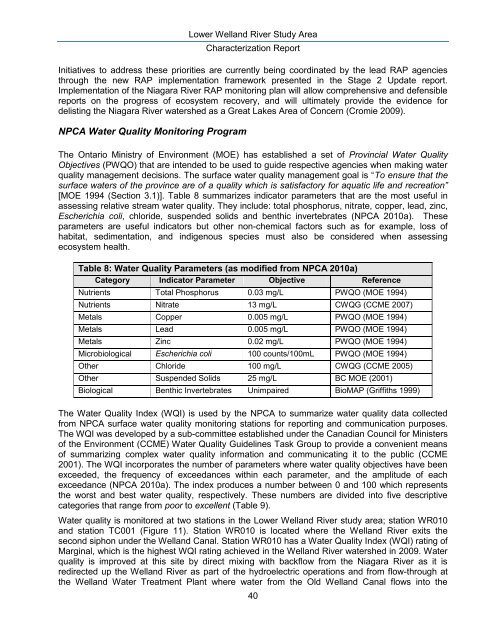Lower Welland River Characterization Report - Niagara Peninsula ...
Lower Welland River Characterization Report - Niagara Peninsula ...
Lower Welland River Characterization Report - Niagara Peninsula ...
Create successful ePaper yourself
Turn your PDF publications into a flip-book with our unique Google optimized e-Paper software.
<strong>Lower</strong> <strong>Welland</strong> <strong>River</strong> Study Area<br />
<strong>Characterization</strong> <strong>Report</strong><br />
Initiatives to address these priorities are currently being coordinated by the lead RAP agencies<br />
through the new RAP implementation framework presented in the Stage 2 Update report.<br />
Implementation of the <strong>Niagara</strong> <strong>River</strong> RAP monitoring plan will allow comprehensive and defensible<br />
reports on the progress of ecosystem recovery, and will ultimately provide the evidence for<br />
delisting the <strong>Niagara</strong> <strong>River</strong> watershed as a Great Lakes Area of Concern (Cromie 2009).<br />
NPCA Water Quality Monitoring Program<br />
The Ontario Ministry of Environment (MOE) has established a set of Provincial Water Quality<br />
Objectives (PWQO) that are intended to be used to guide respective agencies when making water<br />
quality management decisions. The surface water quality management goal is “To ensure that the<br />
surface waters of the province are of a quality which is satisfactory for aquatic life and recreation”<br />
[MOE 1994 (Section 3.1)]. Table 8 summarizes indicator parameters that are the most useful in<br />
assessing relative stream water quality. They include: total phosphorus, nitrate, copper, lead, zinc,<br />
Escherichia coli, chloride, suspended solids and benthic invertebrates (NPCA 2010a). These<br />
parameters are useful indicators but other non-chemical factors such as for example, loss of<br />
habitat, sedimentation, and indigenous species must also be considered when assessing<br />
ecosystem health.<br />
Table 8: Water Quality Parameters (as modified from NPCA 2010a)<br />
Category Indicator Parameter Objective Reference<br />
Nutrients Total Phosphorus 0.03 mg/L PWQO (MOE 1994)<br />
Nutrients Nitrate 13 mg/L CWQG (CCME 2007)<br />
Metals Copper 0.005 mg/L PWQO (MOE 1994)<br />
Metals Lead 0.005 mg/L PWQO (MOE 1994)<br />
Metals Zinc 0.02 mg/L PWQO (MOE 1994)<br />
Microbiological Escherichia coli 100 counts/100mL PWQO (MOE 1994)<br />
Other Chloride 100 mg/L CWQG (CCME 2005)<br />
Other Suspended Solids 25 mg/L BC MOE (2001)<br />
Biological Benthic Invertebrates Unimpaired BioMAP (Griffiths 1999)<br />
The Water Quality Index (WQI) is used by the NPCA to summarize water quality data collected<br />
from NPCA surface water quality monitoring stations for reporting and communication purposes.<br />
The WQI was developed by a sub-committee established under the Canadian Council for Ministers<br />
of the Environment (CCME) Water Quality Guidelines Task Group to provide a convenient means<br />
of summarizing complex water quality information and communicating it to the public (CCME<br />
2001). The WQI incorporates the number of parameters where water quality objectives have been<br />
exceeded, the frequency of exceedances within each parameter, and the amplitude of each<br />
exceedance (NPCA 2010a). The index produces a number between 0 and 100 which represents<br />
the worst and best water quality, respectively. These numbers are divided into five descriptive<br />
categories that range from poor to excellent (Table 9).<br />
Water quality is monitored at two stations in the <strong>Lower</strong> <strong>Welland</strong> <strong>River</strong> study area; station WR010<br />
and station TC001 (Figure 11). Station WR010 is located where the <strong>Welland</strong> <strong>River</strong> exits the<br />
second siphon under the <strong>Welland</strong> Canal. Station WR010 has a Water Quality Index (WQI) rating of<br />
Marginal, which is the highest WQI rating achieved in the <strong>Welland</strong> <strong>River</strong> watershed in 2009. Water<br />
quality is improved at this site by direct mixing with backflow from the <strong>Niagara</strong> <strong>River</strong> as it is<br />
redirected up the <strong>Welland</strong> <strong>River</strong> as part of the hydroelectric operations and from flow-through at<br />
the <strong>Welland</strong> Water Treatment Plant where water from the Old <strong>Welland</strong> Canal flows into the<br />
40

















